Sometimes there’s nothing better than a hot shower or a nice warm bath. It’s one of the luxuries we often take for granted. But, if you are someone with a disability, even those simple pleasures can be impossible. Many times a person with a disability may only get bathed by a sponge bath in bed, which is not a very satisfying long-term solution for most people.
Adaptations for bathing is our focus this month in the Easterseals Resource and Technology Demonstration Center. When considering how to make bathing accessible for someone with a disability, oftentimes the first thought is to completely remodel the bathroom and install a roll-in shower. This may be appropriate in some cases, but in other cases, the cost may be prohibitive. If you are considering this choice, the Resource Center has reference books with information about remodeling and suggestions on what to consider when making renovations to your home for bathroom access. However, besides remodeling, there is a wide range of solutions, including many on display at the Easterseals Resource Center.
SEE BATHING OPTIONS ON DISPLAY AT THE RESOURCE CENTER
One option to make the bathroom accessible might be as simple as a bath chair placed inside a bathtub with a handheld shower. This allows someone who can’t stand to take a shower, to sit and still bathe themselves or get help to do so. Another option could be “The Tub Cut” by Access Designs, Inc., one of the vendors whose equipment is available for viewing in the Resource Center. This “creates any size opening in your existing bathtub.” According to the manufacturer, the process is reversible.
When a bath is desired, the Rane walk-in tub, provided by Prism Medical, demonstrates the comforts of a bath, but with a “low threshold door to enable easy entry and exit”.
If portability is needed, the FAWSsit Foldaway Wheelchair shower is “a completely self-contained portable shower stall”. Using the FAWSsit, a person is able to sit in a shower chair and take a private shower in the most unlikely of places (like the kitchen) then fold up the device and store it until it’s needed next time.
Finally, if the person must be bathed in bed, a device such as the EZ-Bathe inflatable bathtub “allows clients to enjoy a bath or shower without leaving their bed,” according to the manufacturer.
There are bathing adaptations for small children as well, including a variety of bathing supports that can be used to help support a child in the bathtub. The Manatee by Snug Seat, the Robby by Otto Bock, and the Wrap-around Bath Support by Columbia are all examples of bathing supports on display in the Resource Center. Using any one of these devices may provide safer and easier bathing for you and the child for whom you provide care.
Whether it’s a shower or a bath, there are many ways to allow someone with a disability to enjoy that experience. In the Easterseals Resource and Technology Demonstration Center, you can learn more about some of the options available for this important part of living.
To schedule a visit to see these and other items in our Resource and Technology Demonstration Center, write Nancy Ranalli or call (302) 221-2033.
Easterseals does not sell, nor does it receive monetary compensation from any of the dealers or manufacturers listed in this column.


